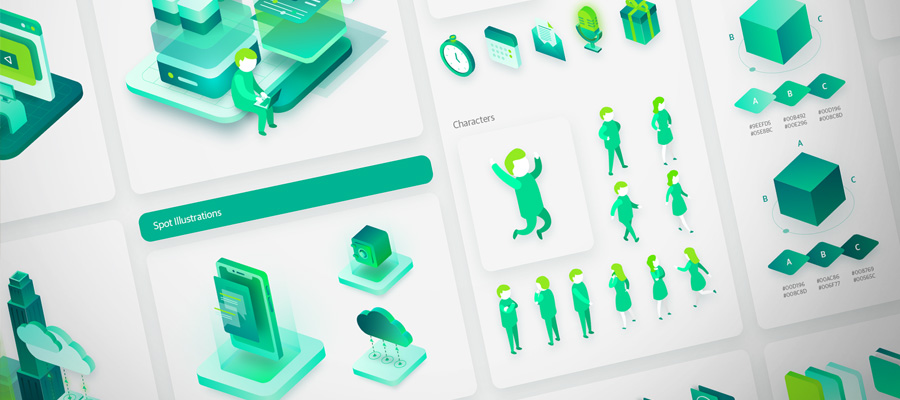With the advent of information and technology, the learning and training landscape has undergone an immense change. The development of new technologies has influenced this landscape in some or the other way. As we’ve made a shift toward eLearning, embracing IT tools has become inevitable. A learning management system is one such technology that provides a platform for eLearning.
A learning management system or an LMS is a web-based technology that helps in planning, implementing, and managing online learning and training. With this creation of online training material and accessing online training has become quite convenient.

illustration by Csilla Gyarfas
However, with growing technology, security and safety concerns have emerged. The fear lingers around whether some unauthorized person accesses the entire information stored on the platform and uses it illegally. After all, it takes a lot of time for the online instructors to design and prepare the eLearning course module. An LMS platform also stores the personal information of the online learners or employees including the other members of the organization. So it becomes the responsibility of the organization to ensure that information security management systems are in place to protect the breach of personal data.
Hence, the organization must ensure that the LMS they are using is well equipped with safety and security features. A learning management system like “Docebo” can be of great help.
An LMS leverage an information security management system of an organization in the following ways:
1. Secure socket layer (SSL)
Initially using the web was not secure. Anyone could visit any webpage any number of times and see what other users are doing. This is very dangerous especially when one is making online payments.
However, today with the adoption of SSL safety has increased. Have you ever noticed a tiny green padlock icon at the top left of your computer or mobile screen near the URL? Well, that is what SSL is. It is a sign that a particular site is safe. SSL or secure socket layer establishes secure links between two connected computers or mobile devices over a network. It helps in data encryption and prevents any third party from reading the information. When an SSL is embedded in a web page it changes the URL of the webpage from HTTP to HTTPS. Here, the suffix S denotes the added security layer.
2. Single sign-on (SSO)
Single sign-on is an authentication process that allows one to access multiple websites or web pages using the same login credentials. To put it simply you don't have to create a different login ID or password while shopping on Amazon, Myntra, or Flipkart.
An SSO is very important for enhancing the security feature of an LMS as it centralizes the entire authentication process. It saves employees and online learners from remembering multiple passwords and login IDs.
3. User access and permission
User access and permission is the primary and most essential security feature that an LMS can provide. Here, users refer to online learners, employees, online instructors, and other members of the organization who will access the eLearning platform. While on the other hand, the permission denotes what information is the user allowed or not allowed to access.
The administrators or eLearning project managers can permit the users to perform certain tasks and edit the existing information. For instance, the administrator can allow the online instructors to upload and edit eLearning material in the online training library, create new online training assessments, and interact with online learners on discussion boards.
Similarly, the administrators can restrict the access to eLearning courses of employees. Also, they can be restricted from viewing other people's online training assessment scores.
Such a demarcation of user access and permission maintains the workflow of the organization by preventing members from stepping into each other's shoes. If this feature doesn't exist, then learners can easily edit eLearning content, manipulate test scores, and leak online training assessment questions. This defeats the purpose of true and honest learning.
4. Password protection
Some of us consider creating passwords a daunting task. And even after giving it a long thought, we end up creating silly passwords like- 12349876, abcdefgh, and so on. Some even use ‘amazon’ as a password for their amazon account. Well, this is how we make the work of hackers easy who can predict such passwords in a minute.
To avoid this problem, organizations can ensure that their LMS offers certain password protection instructions to the users so that they can create a strong password.
For instance, the creation of a password protection policy that describes how many characters, digits, non-alphanumeric characters, lower or uppercase letters the password should contain. They can also remind employees to change their passwords frequently (say, after every six months). The administrators also may force the learner to log out immediately after changing the password. Finally, they can set the expiry period in case of a failed login, just like any e-commerce site does.
5. Login and authentication
This feature in LMS is very useful in corporate training. It allows the organization’s administrators to decide who can sign up and when and how they can log in. This is especially needed for those organizations which use a cloud-based LMS platform. For instance, an LMS of an organization can restrict the registration by allowing only certain domains to access the eLearning platform. Hence, only the registered employees and learners can access the eLearning resources. Here, an extra layer of protection can also be added by allowing the administrators to give the final registration approval. In this way, the security of the eLearning platform will not be compromised at all.
6. Backups and disaster recovery
Apart from the above-mentioned safety options, maintaining a backup of all the data (eLearning course modules, personal chats, online training resources, and so on) is equally important. After all, you just can't keep crying when a hacker breaks into your system.
Thus, the best LMS is one that gives your organization an option to backup all the critical data. Also, it can keep reminding employees weekly or monthly about the need to keep a backup.
Conclusion
After a rapid increase in cybercrimes, it becomes important that an LMS has built-in information security features. After all, nothing can be more important than giving secure access to learners and employees and at the same time ensuring that the information stored isn't stolen or manipulated.




















